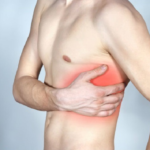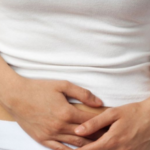Symptoms and methods of treatment of a hernia in the cervical spine
An intervertebral hernia of the cervical spine is a dangerous pathology in which the disc connecting two vertebrae begins to deform, and its contents go beyond the joint. The risk lies in the fact that the protrusion of the structure occurs in the area where the nerve roots, large vessels and spinal cord are located, damage to which has unpleasant consequences, up to disability.
The cervical region is the most mobile, it has a small load, it holds the head, ensuring its turns. When pressure on the vertebrae increases due to injury or another factor, the disc may not withstand, deform, and a hernia begins.
The vertebral artery runs through the neck and carries blood to the brain. The pulp that has gone beyond the fibrous ring can damage it, which will lead to impaired cerebral circulation. And this is far from the only complication that a hernia of the cervical spine can provoke.
Why does a hernia appear
The disease is more common in men over 60 years of age. The risk group includes athletes, drivers, people who prefer extreme recreation.
The cervical region accounts for 10% of all disc herniations, and most often the disorder occurs in the lumbar region.
A herniated disc in the cervical region may be the result of the following conditions:
- occupational hazards, when the neck constantly makes monotonous movements;
- sharp turns of the head, frequent neck injuries, high pressure on the spine;
- osteochondrosis - pathology precedes a hernia, leads to fragility and deformation of the fibrous ring of the disc due to tissue malnutrition;
- spondylosis - inflammation of the joint between the vertebrae, the violation leads to an incorrect distribution of the load on the intervertebral discs.
There are also risk factors that contribute to the occurrence of a hernia in the cervical region:
- chronic diseases of the spine, diseases of bone and cartilage tissue;
- poor posture, stoop, sedentary work, lack of movement;
- dehydration of the body, which leads to premature aging of the joints;
- smoking affects the whole body, in particular, disk tissues suffer from a lack of oxygen;
- constant impact of vibration on the body;
- congenital malformations of the vertebrae;
- overweight, obesity;
- endocrine diseases, avitaminosis and hypervitaminosis.
Signs of the disease
A hernia in the cervical spine begins with a feeling of discomfort, then it becomes painful and difficult to lower the head, it is impossible to reach the sternum with the chin. This is accompanied by headache, fatigue, pallor and periodic numbness of the skin.
Education has different sizes, and the severity of symptoms will also depend on this. It also happens that the radiological signs do not coincide with the sensations of the patient, a large hernia does not appear for a long time, but from this it poses an even greater threat.
Symptoms of a cervical hernia will depend on the location:
- C1-C2 - headaches, frequent and sudden dizziness, noise and ringing in the ears, impaired coordination, darkening in the eyes;
- C2-C3 - increased sweating, migraine, depression, depression, impaired taste sensations;
- С3-С4 - violation of the sense of smell, damage to the trigeminal nerve, decreased hearing and vision;
- C4-C5 - diseases of the auditory pathway, damage to the facial muscles, frequent inflammatory diseases of the nasal and throat mucosa, problems with shoulder flexion, heaviness when tilting the head down;
- C5-C6 - frequent tonsillitis, recurrent diseases of the oral mucosa and nasopharynx, soreness in the arm, severity of elbow flexion, burning and numbness of the skin in the forearm, muscle weakness;
- C6-C7 - chronic diseases of the respiratory system, frequent dry cough, burning and showing the skin in the area of the hand, weakness of the triceps and biceps, voice change;
- C7-T1 - pain in the shoulder and shoulder blades, dysfunction of the thyroid gland, muscle weakness, general malaise, impaired sensitivity of the skin of the hands.
stages
The development of an intervertebral hernia occurs in several stages, at each state of health and radiological signs will be different.
There are 4 stages of disc herniation formation:
- Protrusion - a crack appears in the fibrous ring, through which the pulp begins to gradually exit. At this stage, the patient is shown a rest mode for the spine, sharp movements and hard physical work are excluded. Without following the doctor's recommendations, the disease progresses, the nucleus pulposus comes out, this will already be the first stage of a hernia with a size of 2-3 mm.
- Partial prolapse - the pain becomes chronic, local blood circulation is disturbed, the nerve root swells, the size of the hernia in the second stage reaches 10 mm;
- Complete prolapse - the pulp completely extends beyond the disc while maintaining the integrity of the core, intense pain spreads to the leg. The third stage is considered severe, there is a risk of disability, the size of the formation is up to 15 mm.
- Sequestration is the last stage, when the pulp fragments begin to move freely along the spinal canal, the disc is displaced, and the nerve roots are damaged.
At the sequestration stage, surgical removal of a herniated disc with a damaged disc is indicated. Without surgery, there is a risk of disability, because the doctor will always insist on radical treatment.
Diagnostics
Confirmation of the disease is carried out by MRI or radiography. Doctors prefer to prescribe magnetic resonance imaging, because then it is possible to see not only the defect itself, but also to assess the state of surrounding structures, blood vessels and nerve roots.
To detect a hernia in the cervical region, the following research methods are prescribed:
- x-ray is the simplest and most accessible method, but it will only be a method of preliminary diagnosis; it is impossible to accurately describe the disease from x-ray images;
- MRI is the gold standard in the diagnosis of intervertebral hernia, based on the results, a diagnosis is made, conservative treatment and a radical removal technique are selected;
- CT - like MRI is excellent for detecting the disease and related disorders, it clearly sees solid structures, MRI - soft tissues;
- myelogram - X-ray examination with a contrast agent, is performed to assess the degree of stenosis of the spinal canal, the method has a limited list of indications and a large number of contraindications.
Methods of treatment
About what to do with a hernia of the cervical spine, you can only learn from the attending physician, who is familiar with the results of all studies and the history of the disease. Treatment will be carried out with conservative methods at stages 1 and 2 of the disease, but when there is a large defect or sequestration, surgery is indispensable.
How is a herniated disc in the neck treated?
- Mode.
Compliance with the regimen implies rest for the sick back, and a fixing orthosis, in particular the Shants collar, would be a good solution to this problem. This is necessary to reduce the load on the neck so that the damaged disc can recover. The collar must be worn during the period of pain. During an exacerbation, you will have to use it constantly, even during sleep. Then it will be possible to remove it for several hours, so that the neck gradually gets used to it.
- Medications.
The main groups of drugs for hernia of the spine:
- anti-inflammatory - are prescribed to all patients to eliminate the pain syndrome by eliminating the focus of inflammation, are indicated for intramuscular administration and oral administration, Ibuprofen, Nimesil, Diclofenac, Denebol are more often used;
- chondroprotectors - slow-acting drugs, they need to be taken in a course of at least six months, representatives - Structum, Don;
- muscle relaxants - remove muscle spasm, reducing the level of compression of the nerve roots, first administered intravenously, then taken orally, these are Mydocalm, Sirdalud;
- glucocorticosteroids - are prescribed along with novocaine when there is muscle weakness, symptoms of skin numbness and burning.
With a herniated disc, medications must be taken almost always, which is not safe for the stomach and the whole body. Some groups of drugs are best delivered to the diseased area through the skin, by phonophoresis or electrophoresis.
- Physiotherapy.
Physical methods are applied from the second week after the onset of acute symptoms, when the pain subsides and the patient can move normally. It is good to combine physiotherapy with massage and manual techniques, but they have many contraindications, therefore they are rarely prescribed.
With a hernia of the cervical spine, the following methods of physiotherapy are useful:
- electrophoresis with anesthetics;
- magnetotherapy;
- acupuncture;
- therapeutic baths;
- diadynamic therapy;
- paraffin wraps.
Kinesitherapy on special simulators is indicated at an early stage of the disease and after surgery. At home, you can do therapeutic exercises without additional devices or using the Evminov board.
Anesthesia
To relieve pain, tablets, injections, ointments, blockades and individual exercises are used. You can use local remedies on your own - cooling gels, compresses, applications, these can be Finalgon, Kapsikam ointments.
Rubbing the product in the area of the diseased disc stimulates blood flow and improves nutrition. Substances, entering the lesion, weaken the severity of the pain syndrome.
Blockade of the spine is carried out by injecting an anesthetic directly into the focus of the pathology. Injections are prescribed in a course for several days until you feel better. As an anesthetic, novocaine and lidocaine are most often used.
How is a hernia removed?
When conservative therapy fails, surgical treatment is indicated. The operation is performed with complete or partial removal of the disc. In some cases, laser vaporization is enough to relieve severe symptoms for a while, then the procedure can be repeated several times.
So that the operation does not only make it worse, the decision on radical treatment is made only in extreme cases, when all other methods have been tried.
The main ways to remove a hernia in the cervical region:
- Anterior discectomy . The disk is removed partially to create access to the defect. An incision is made on the front surface of the neck 3 cm long, then the vessels, nerves, muscles are exfoliated. After removal of the hernia, the cavity is filled with bone mass or an implant is installed to preserve the mobility of the vertebrae.
- Endoscopic discectomy . It differs by the absence of the need to make an incision and remove tissue to create access to the hernia. Everything is carried out with small instruments, the doctor watches what is happening on the screen.
- Posterior discectomy . The incision is made on the back of the neck, the tissues are pushed back with a gauze swab until the vertebra is exposed, the bone tissue is partially removed, the defect is removed, and the space in the area of the compressed nerve is simultaneously expanded.
Rehabilitation after removal of a herniated disc
After the operation, the regimen will be even more gentle. It is necessary to ensure complete rest of the cervical region, for which a special collar is used. You will have to wear it day and night for several days, then take it off for a while.
The first 3 months after the operation, it is permissible to lift a weight of no more than 3 kg. From the second week, the doctor prescribes physiotherapy and light exercises in the form of gymnastics for the neck. A month later, you can start visiting the gym and do more complex exercises to strengthen muscles, but only under the supervision of an instructor.
Complications
Consequences of a herniated cervical disc without treatment:
- violation of motor function, paralysis or decreased sensitivity of the hands;
- respiratory arrest due to infringement of the spinal cord;
- the risk of early stroke due to circulatory disorders in the brain;
- curvature of the spine, torticollis;
- neurological disorders, depression, hearing and vision loss.
The operation can also result in severe complications, so you should always remember the importance of prevention.
With a hernia of the cervical region, sharp turns of the head are contraindicated, it is not recommended to sit at the computer for a long time and do other things when you need to strain your neck and keep it in one position for a long time. It will be useful to purchase a hard orthopedic pillow and sleep on a hard mattress.










